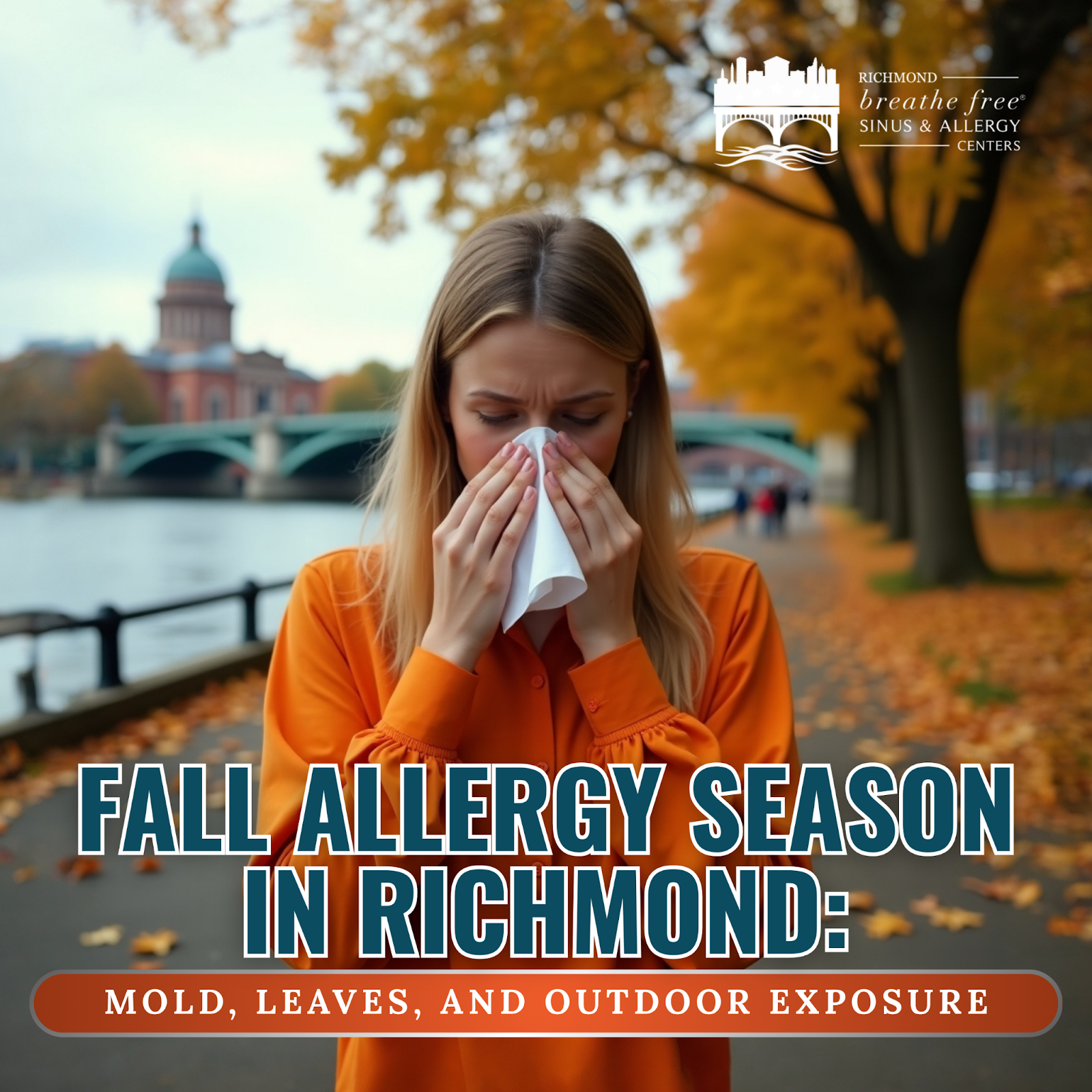Fall Allergy Season in Richmond: Mold, Leaves, and Outdoor Exposure
For many in Richmond, fall is the favorite season of the year. Cooler weather, colorful foliage, and outdoor events make it a beautiful time to be outside. But for allergy sufferers, autumn can also bring weeks of sneezing, congestion, and sinus headaches. The combination of falling leaves, damp conditions, and lingering pollen can make symptoms worse — especially if you already deal with sinus problems.
At Richmond Breathe Free, we help patients every year who struggle during this season. Here’s what you should know about fall allergies, how mold and leaves contribute to symptoms, and where to find real solutions.

Mold and Wet Leaves
One of the biggest culprits behind fall allergies in Richmond is mold. When leaves start falling and pile up in yards or gutters, they hold moisture. That damp environment becomes the perfect breeding ground for mold spores.
When you rake or bag leaves, those spores are released into the air and can easily be inhaled. For people with allergies, mold exposure often leads to:
- Stuffy or runny nose
- Itchy, watery eyes
- Sinus pressure and headaches
- Coughing or throat irritation
Even if you’re not the one doing yard work, mold spores can travel through the air and trigger symptoms.
Outdoor Exposure During Fall Activities
Fall in Richmond means festivals, football games, and enjoying the changing leaves. Unfortunately, being outside for long stretches increases exposure to both mold and pollen. Ragweed pollen can linger into October, and when combined with mold, it creates a tough season for anyone prone to allergies or sinus infections.
Simple things like sitting on damp grass, hiking through wooded areas, or even walking through piles of leaves can stir up allergens. That’s why many people report worsening congestion and sinus pressure in the fall.
Tips for Managing Sinus Pressure
If you feel heavy pressure around your forehead, cheeks, or eyes this season, you’re not alone. Sinus inflammation is a common reaction to fall allergens. Here are some practical ways to ease the discomfort:
- Rinse with saline. Using a saline spray or rinse can flush out allergens and reduce swelling in your nasal passages.
- Shower after yard work. This washes mold spores and pollen off your skin and hair.
- Wear a mask when raking. A simple mask can limit how much mold you breathe in while handling leaves.
- Stay hydrated. Drinking plenty of water helps thin mucus and relieve congestion.
- Use a dehumidifier indoors. Keeping humidity levels low makes it harder for mold to grow inside your home.
When to Look for Professional Help
Over-the-counter medications may help with mild flare-ups, but they don’t always provide lasting relief. If you’re struggling with ongoing sinus infections, constant congestion, or severe headaches every fall, it may be time to see an ENT.
At Richmond Breathe Free, we offer diagnostic tools and treatment options that help many patients manage recurring sinus and allergy symptoms. That might include allergy testing to see exactly what’s triggering your reactions or advanced sinus treatments that open blocked passages and improve airflow. Patients looking for fall allergy help in Richmond often find that getting specialized care is the first step toward long-term relief.
Enjoy Fall Without the Discomfort
Fall should be about enjoying the season — not feeling weighed down by sinus pressure and allergy symptoms. By taking steps to limit exposure and knowing when to seek medical care, you can make the most of autumn in Richmond.
If allergies or sinus issues are keeping you from enjoying the season, Richmond Breathe Free is here to help. From simple sinus pressure tips to advanced treatment options, we’ll help you explore treatment options tailored to your needs and designed to reduce symptoms.
Don’t let mold and leaves take the fun out of fall. Call today to schedule an appointment and take the first step toward breathing easier.

.png)